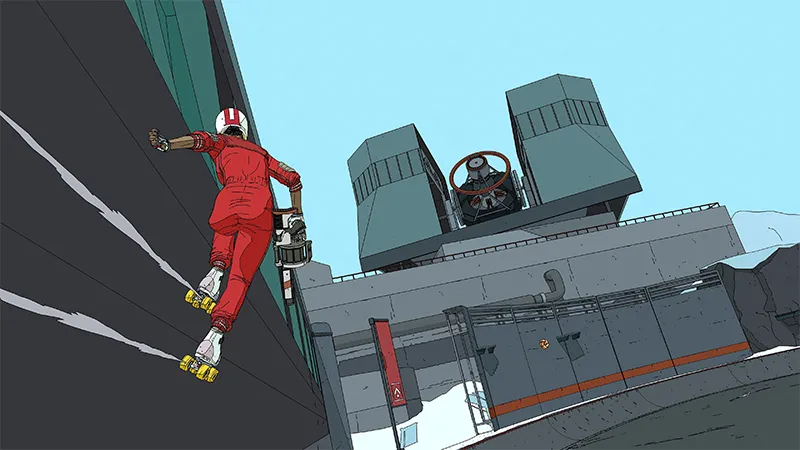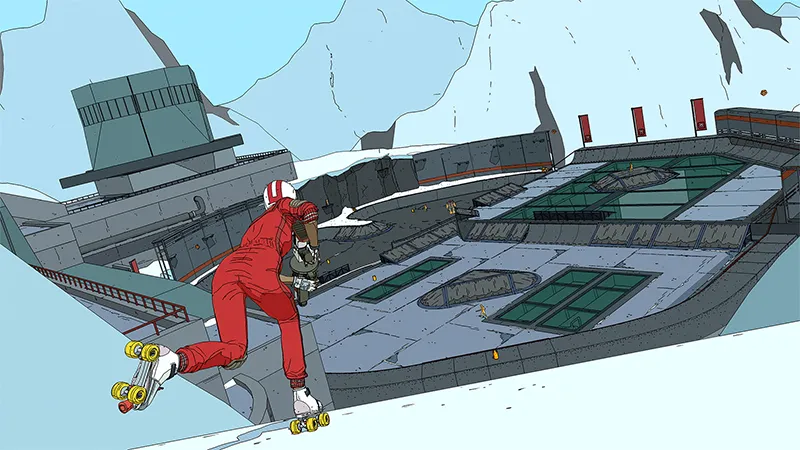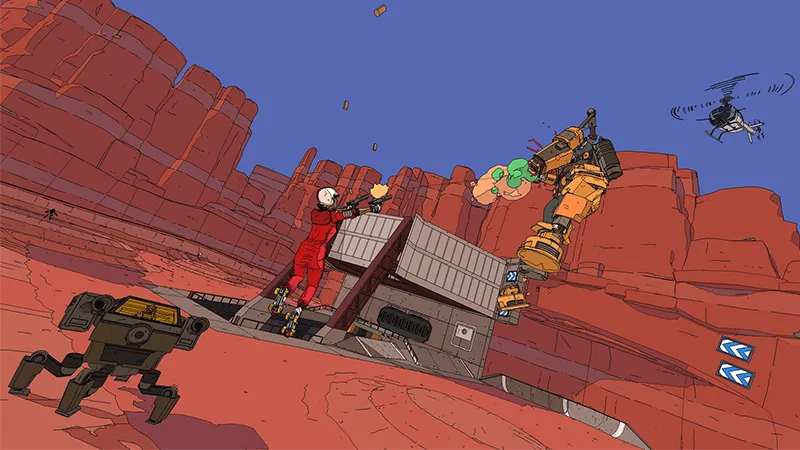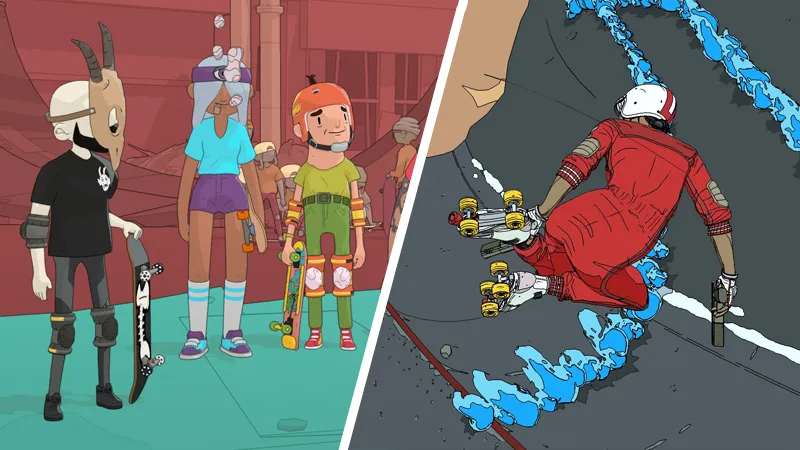Even small studios don’t typically put out more than one game in a calendar year. But Roll7 is doing exactly that and more, as it released OlliOlli World in February and its first expansion in June and is just on the cusp of releasing Rollerdrome and the second untitled OlliOlli World expansion (which is slated for the fall). It’s a lot by any measure and was one of the few topics ComingSoon Senior Gaming Editor Michael Leri covered while speaking to Head of QA David Jenkins and Lead Producer Drew Jones. Jenkins and Jones also talked about the studio’s love for games built to evoke a flow state, Rollerdrome‘s 1970s aesthetic, and more.
Michael Leri: Roll7 released an interesting dev diary about the game and it contained a look at the game in its very early stages. Obviously now, it looks very different. How did the team settle on the cel-shaded, Sable-esque art style and 1970s tone?
Drew Jones: There is a logical sequence to how it all came together. The original prototype of the game was always roller skating with guns and we knew that after making the prototype and making sure that that was something people thought was fun, we proceeded to make a game out of it. Because it is a bloodsport, a lot of the references just slotted into place. It’s just a wealth of fantastic inspiration from the 1970s in particular where bloodsports were in. New things like roller skates were coming around and we had films like Rollerball and The Running Man [Editor’s note: The Running Man book released in 1982 and the film came out in 1987]. Part of why the references are in the 1970s are because the ‘70s were such a key connection between the genre of the game.
RELATED: Rollerdrome Preview: Death Skate 2000
There are two main reasons why the game has this art style. The first one is we didn’t want it to be photorealistic. And we knew it couldn’t be too busy. There’s too much going on especially when it gets thick and fast and we need things to stand out and pop. If there’s too much detail, a lot of the gameplay readability is sacrificed. We didn’t want it to be complicated. But we also wanted it to be beautiful. And after looking through a lot of references, we aligned on this flat color for the simplicity but also because it is a striking thing. We already had some really good rendering tech from OlliOlli World and we just tried to push that in a different direction where it was less cartoony but still comic booky.

Rollerdrome is a real systems-heavy game, which is reminiscent of OlliOlli World. Both of these games have a similar deep foundation of skill-based combos and a high skill ceiling. Given those basic similarities, how does making some like OlliOlli help with creating Rollerdrome?
Jones: I think Rollerdrome taps into the DNA of Roll7. It’s got the extreme sports angle, like previous Roll7 games like Laser League which was an arena-based bloodsport kind of thing. Not a Hero was a fast-paced moment-to-moment shooting game. Not through any sort of contrivance, we just ended up with — and I am going to say the “synergy” word — a synergy of all of those elements. A lot of those elements are there in some way shape or form, but not any one of them stands out. It’s a nice balance.
The thing that links all of those games and what’s at the real heart of what we are trying to do at Roll7 is flow. We want to make a game where players just get into this state where one action beautifully leads to the next one. And the player is engaged but not stressed or taxed. That’s the kind of balance that we want to strike. Once you really get into the game’s mechanics, you are just gliding through the level and you are paying a lot of attention because it is easy to fail, but when you get into that groove and you look at the clock and it’s been like an hour.
David Jenkins: The fun challenge of making these in parallel, and being in QA where we flip between the two, was to do what we did with OlliOlli World in terms of the level layouts. The way one thing moves on to the next and you hit all these beats, doing that in a 2D space is relatively easy compared to doing it in a 3D space. Because in a 2D space, we know about how fast you will probably be going and what direction you’re going. In a 3D space, you can be going in any direction at any speed and that made putting the levels together more difficult but also more rewarding when we nail it.
And then to combine it with the additional mechanics, it is not just about where the ramps, quarter pipes, and grind rails are, it’s where the ramps are relative to the sniper or rocket guy is. And that was fun to iterate on and contribute to that as part of our wider role in QA that goes beyond just testing. It’s the actual QA bit that I think gets lost sometimes where we are actually assuring it is a quality product and not just saying that it works.

The aforementioned video did a good job of explaining how the levels are designed to encourage this sort of flow state that is nudging the players back into the action. Can you speak to finding that flow state and how important it was to nail?
Jones: For me, every action should lead to the next. In Rollerdrome, you do a trick that will replenish your ammo and you come back down, you are presented with a bunch of options. You can turn left and face a ramp. You can go forward where there might be an enemy. Or you can turn the other way and do a grind or something. The options are always there and players never have to think too consciously or too hard about the next action. The next action is just always there and because there is constant movement it’s almost like a fait accompli. Like you have to make your decision on what to do next because you’re moving towards it.
One of the eureka moments is when you hit that loop of doing tricks to reload your ammo and killing enemies to refill your health. That’s the core repeatable loop within the gameplay. Once we had that, it really did start to behave how I just described. The skating and shooting just complement each other and you really can’t do one without the other and both of them really pull you along into taking the next action. With a bit of refinement, we got to the point where it isn’t autopilot, but your brain is active and it is doing the work, but it’s not a conscious thing. For me, when you really get into the zone, it’s relaxing in a really perverse way because you’re shooting guns and rockets.
Jenkins: You really hit that autonomous state. I used to teach kickboxing and the learning goes through the cognitive phase, then the associative phase, and then autonomous phase. And the autonomous phase is where you start hitting that real flow state. You’re not consciously going, “Oh, there’s an enemy over there. I think I will change to the shotgun.” Your brain isn’t thinking those things in a drawn out way. You just feel and it all starts to take shape. And that’s when you can start planning ahead and that’s when you start really getting into the nitty gritty.
I like how the shooting and trick mechanics are tied together through the score system and although the score system isn’t essential to the game, it should almost feel like it is. Like you as the player should want to get a high score even if it makes no difference to anything.

Roll7 is release two games and two expansions this year. How did that all come about so closely? And how is Roll7 handling it without overworking its team members into the ground?
Jones: When Roll7 caught wind of the idea, it was an idea they wanted to take seriously. I think they just loved the idea so much that they thought it should be a Roll7 game. It just makes too much sense to do it. OlliOlli World was already in the early stages of development at that point so we weren’t too far behind.
It’s also not exclusive, but we tried to maintain two separate development teams. Making a video game is hard and it takes a lot of mental energy and you really have to dive into it, so for many roles and departments, we basically operated two different development teams. Certain people on the dev side worked on both projects, but we definitely didn’t want to spread people too thin because if people are a little bit frazzled, they tend not to deliver the best results. The main department that worked on both games is QA.
RELATED: Interview: How the OlliOlli World Devs Made Their Dream Game Without Crunching
Jenkins: And what we tried to make sure we were doing that in an intelligent and deliberate way. It wasn’t just a case of everyone doing it all at the same time. We had some people who were dedicated to the project to a length of time and then we would bring other people over and swap people around to keep them fresh and keep them from burning out and doing the same thing over and over again. But we also did it to keep fresh eyes on the projects. We did a lot of playtesting internally with the other team. We did a lot of testing internally with Private Division, which was fantastic. We got a lot of people to get their hands on this game to help make sure that it was exactly what we think it is and exactly what we wanted to be.
We made some very deliberate efforts within QA in particular to tell certain people, “Don’t touch it. Don’t go near it. Leave it alone. I know it looks awesome, but leave it alone for a minute and we will come to you. You will get your chance.” And we would give them a questionnaire and record their footage of their first playthroughs so we could get their brand-new, untouched experience but also from a QA perspective because we have a unique perspective on games. We tend to be the ones who play games the most, not just our own games but generally, and we tend to be the ones who just enjoy games the most and have an eye for detail and being quite good at giving feedback. That is why we do what we do; we are suited for that kind of thing.
QA did a lot of crossover, but in terms of how we do that without feeling stretched, the producers did a hell of a job structuring things, planning everything, and scoping out deliverables and all that fun stuff that most people don’t see or care about in terms of the wider gaming audience. And what you don’t see in dev diaries is how much effort goes into making sure the game is actually ready when it is supposed to be ready and there was a lot of effort put into making sure that that was the case and that we never got to a point where we didn’t have enough people or time.
I feel like we always pretty much had exactly what we needed at any given moment and that is very much down to the production team and Private Division for giving us the freedom to do that and to stay true to who we are as a studio. It’s been a really good blending and balancing of everything and it’s all come together and I just can’t wait for people to play it and tell us how awesome it is.










